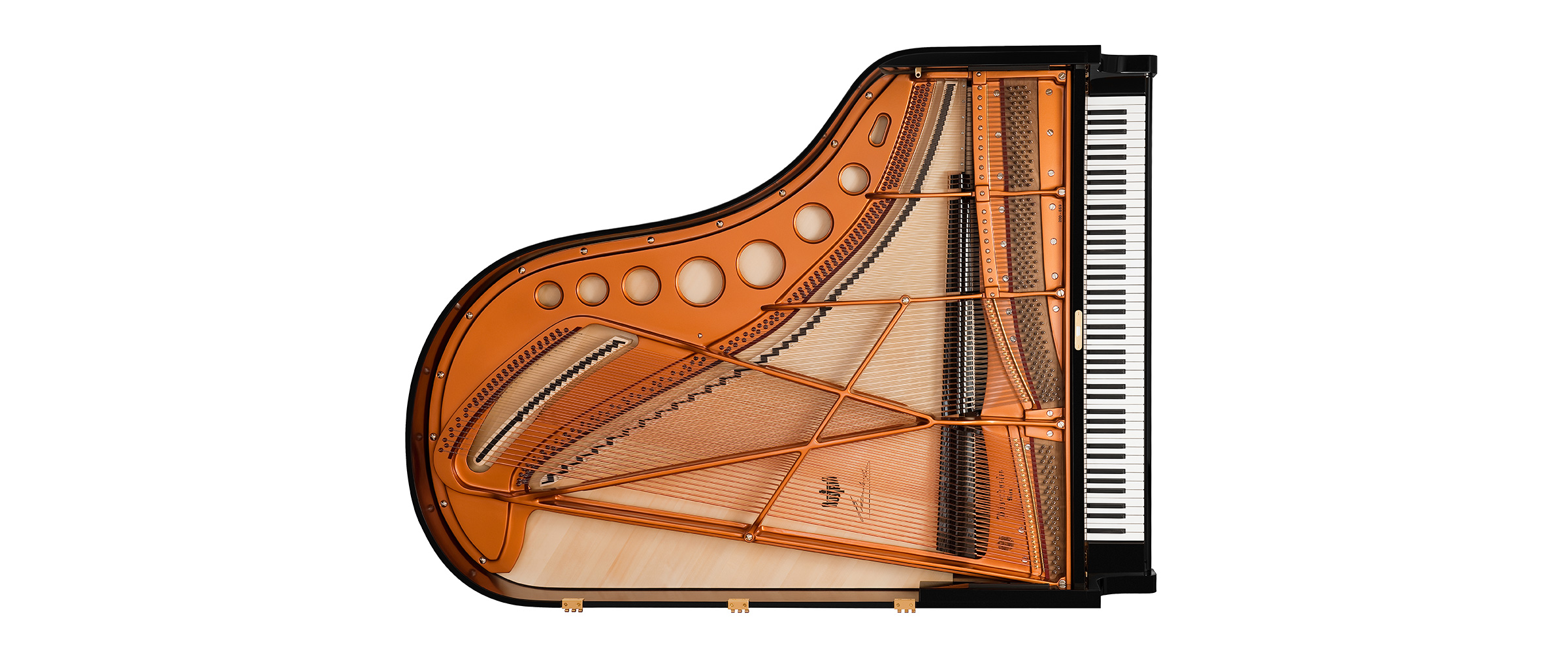There are many different brands and models of pianos, but when it comes to premium piano brands, Steinway and Bosendorfer are at the top of the heap. Every player knows of Steinway, but fewer people are aware of Bosendorfer. Many players have never even heard of Bosendorfer let alone played on one.
Despite Steinways’ reputation as the best, many players actually prefer to play on a Bosendorfer. Let’s break down the differences between these two brands.
Bosendorfer and Steinway & Sons: A Brief History
Bosendorfer was founded in 1828 in Vienna, Austria. By 1830, Bosendorfer was granted the status of official piano maker to the Emperor of Austria. In 1838, Hungarian composer Franz Liszt chose a Bosendorfer grand piano (quite the endorsement at the time) for a concert in Vienna to best suit his intense, powerful style of playing. Liszt left it all on the keys, finally unconstrained by a new, strong, high-quality instrument. This concert catapulted Bosendorfer to musical fame.
Meanwhile, Steinway didn’t produce their first piano until 1853 in New York, some 25 years after Bosendorfer was founded. Yet, by 1880, Steinway had become the piano standard for players and composers.
Neither Steinway nor Bosendorfer are owned by their original families anymore, but Steinway’s popularity has not waned after all this time (their market share of the high-end piano industry exceeds 80 percent to this day). But how?
Well, Steinway has been credited as being an innovator in piano development, with more than 130 patents to date. One of their most important patents came in 1859. This invention saw the bass strings in a piano “overstrung” above the treble strings to provide improved tonal quality. This has since become a standard feature of grand pianos.
Additionally, Steinway was and is one of the best marketers for their brand in the piano-maker industry. This largely has to do with Heinrich Steinweg, a German piano-maker and founder of Steinway & Sons, coming to America to enter the larger and more lucrative American piano concert market, a market Bosendorfer never really entered.
Variety of Models
Bosendorfer
Bosendorfer currently has 8 grand pianos and 1 upright piano that are widely available. From their upright piano and smaller grand pianos to their largest concert grand piano, Bosendorfer makes each piano with the highest quality materials by hand (a process that may take up to a year).
Uniquely, Bosendorfer makes a few models of grand pianos with more than the standard 88 keys. Their Grand Piano 225 has an extra 4 keys in the bass end, and their Concert Grand 290 Imperial has 97 keys (a full 8 octave range). The extra 9 keys in this model are also in the bass end of the keyboard. The keys are colored black to signify they are not among the standard 88 keys. These extra keys are said to give the piano a fuller, orchestral sound.
Though it is rare a musician would need the extra keys, certain works by composers such as Maurice Ravel and Claude Debussy require the extra keys, such as Gaspard de le nuit (Ravel) and La cathédrale engloutie (Debussy).
Steinway

Steinway currently produces 6 different grand pianos as well as an upright piano. The 6 different models of grand pianos Steinway has are different lengths and sizes, ranging from their Baby Grand Model S piano (61 inches long) to their Concert Grand Model D piano (108 inches long). Each of these models is hand-crafted with the finest materials that give Steinway pianos their rich sound. As the size of the piano is increased, the sound produced is of a higher quality and fills more space.
Interestingly, Steinway’s American pianos (made in Queens, New York) are said to be slightly different than those made in Hamburg, Germany. Many musicians prefer Steinway’s German-made pianos, citing slightly higher quality, though the difference is likely minimal. Of course, you are free to order from either Steinway factory, though shipping costs may vary.
Price
Steinway and Bosendorfer are two of the best piano brands in the industry, so they won’t come cheap. For the price we’ll use MSRP, which means manufacturer’s suggested retail price, for each brand’s current models. Also note that grand pianos are measured lengthwise while upright pianos are measured by height.
Bosendorfer
Bosendorfer’s current models of grand pianos range from $121,999 – $306,999, in USD. See below for each individual model:
| Model (and size in inches) | Price in USD (MSRP) |
| Grand Upright 130 (52 in.) | $89,999 |
| Grand Piano 170VC (67 in.) | $146,999 |
| Grand Piano 185VC (73 in.) | $155,999 |
| Grand Piano 200 (79 in.) | $166,999 |
| Grand Piano 214VC (84 in.) | $177,999 |
| Grand Piano 225* (88.5 in.) | $209,999 |
| Concert Grand 230VC (90.5 in.) | $200,999 |
| Concert Grand 280VC (110 in.) | $262,999 |
| Concert Grand 290 Imperial* (114 in.) | $306,999 |
Source: Bosendorfer Piano Pricing
Steinway
Steinway’s current models of grand pianos range from $80,100 – $198,400, in USD. See below for each individual model, including their upright piano:
| Model (and size in inches) | Price in USD (MSRP) |
| Model K-52 Upright (52 in.) | $46,900 |
| Model S Baby Grand (61 in.) | $80,100 |
| Model M Medium Grand (67 in.) | $86,200 |
| Model O Living Room Grand (71 in.) | $95,800 |
| Model A Salon Grand (74 in.) | $110,500 |
| Model B Classic Grand (83 in.) | $124,900 |
| Model D Concert Grand (108 in.) | $198,400 |
Source: Steinway Piano Pricing
It is also important to note that while Steinway makes their pianos in New York (to serve the Americas) as well as in Hamburg, Germany (to supply the rest of the world), Bosendorfer only manufactures pianos in a suburb near Vienna, Austria. This means shipping elsewhere, such as the United States, would add international shipping costs, which run high.
Sound and Action

Bosendorfer
Bosendorfer crafts every piano with what they refer to as the “Bosendorfer DNA,” the materials and processes uniquely used to make their pianos. Bosendorfer pianos produce a pure, deep, full sound with rich tones. This is in part due to the use of hand spun bass strings made with a steel core and a layer of copper.
Bosendorfer’s use of spruce wood results in a deep bass and a clear treble; this is because spruce wood, a softer wood, transmits sound rather than reflects it, creating a more resonant sound. Because the sound is absorbed rather than reflected, distortion may occur when under pressure.
Additionally, Bosendorfers have a fast action, which allow players to be dynamic and increase speed while remaining clear. A faster action also means a player may have a slightly harder time with control at a higher speed, though as mentioned, sound will remain clear.
Steinway
The “Steinway sound” is largely unique due to its patented “diaphragmatic soundboard.” It allows dynamic sound as well as a fuller sound. A soundboard made of soft spruce wood paired with a frame made of maple hardwood allows rich sound to project loudly without compromising any quality and maintaining clarity.
Compared to the Bosendorfer, the bass is not as clear, and can produce a muddled sound if a player is active in the bass. In the treble, where some pianos can get brittle in sound, Steinway maintains full, bell-like sounds.
The action on a Steinway is very stable and responsive, thanks to materials in the action frame that reduce friction and resistance. Steinways have slightly slower action overall, but lab tests prove that repeated notes can be played 13% faster on a Steinway than on any other piano.
Conclusion
Ultimately, these 2 beautiful, high-end piano brands are about as good as it gets. They are different and, depending on what you value most in your piano, you may think one is a clear winner over the other. As for me, I’m personally a Steinway fan, but the limited time I have spent playing a Bosendorfer Grand seriously gave Steinway a run for its money. The touch and sound of each is unique, and you really have to play both to know which is right for you.

